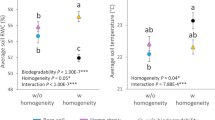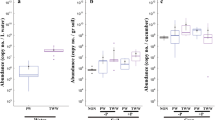Abstract
In experiments conducted in Darwin, Australia, temperatures generated during November at 25 cm depth in nursery potting mix by solarisation reached maximum values of 51°C and 44.6°C under a double and single layer of clear plastic mulch, respectively. The lowest temperatures were 41.3° and 38.1°C in July under the double and single layer of clear plastic mulch, respectively. Acyclic pattern of temperatures occurs over a 12 month period, following closely the global radiation figures. Three soilborne plant pathogens, Pythium myriotylum, Phytophthora nicotianae var. nicotianae and Sclerotium rolfsii were eliminated under a double layer of plastic within 2–8 days during the spring, summer and autumn experiments while it took 4–20 days at the same time of the year to eliminate the same pathogens using a single layer of plastic.
Similar content being viewed by others
References
Barbercheck, M.E. and von Broembsen, S.L. (1986) — Effects of soil solarisation on plant parasitic nematodes and Phytophthora cinnamomi in South Africa. Plant Disease 70: 945–950.
Ben-Yephet, Y., Stapleton, J.J., Wakeman, R.J. and DeVay, J.E. (1987) — Comparative effects of soil solarisation with single and double layers of polyethylene film on survival of Fusarium oxysporum f.sp. vasinfectum. Phytoparasitica 15: 181–185.
Duff. J.D. and Barnaart. A. (1992) — Solarisation controls soilborne fungal in nursery potting mixes. Australasian Plant Pathology 21: 20–23.
Hardy, G.E. ST.J and Sivasithamparam, K. (1985) — Soil solarisation: Effects on Fusarium wilt of carnation and Verticillium wilt of eggplant. In Ecology and Management of Soilborne Plant Pathogens (Eds A. D. Rovira, K.J. Moore, P.T.W. Wong, and J.F. Kollmorgen), pp. 279–281. American Phytopathological Society, St Paul Minnesota.
Hartz, T.K., Bogle, C.R. and Villalon, B. (1985) —Response of pepper and muskmelon to row solarization. Hort-Science 20: 699–701.
Juarez-Palacios, C., Felix-Gastelum, R., Wakeman, R.J., Paplomatas, E.J. and DeVay, J.E. (1991) — Thermal sensitivity of three species of Phytophthora and the effect of soil solarisation on their survival. Plant Disease 75: 1160–1164.
Kaewruang, W., Sivasithamparam, K. and Hardy, G.E. (1989) — Effect of solarisation of soil within plastic bags on root rot of gerbera (Gehera jamesonii L.). Plant and Soill 20: 303–306.
Kassaby, F.Y. (1985) — Solar-heating soil for control of damping-off diseases. Soil Biology and Biochemistry 17: 429–434.
Katan, J. (1980) — Solar pasteurisation of soils for disease control: Status and prospects. Plant Disease 64: 450–454.
Katan, J. (1981) — Solar heating (solarization) of soil for control of soil-borne pests. Annual review of Phytopathology 19: 211–236.
Katan, J., Fishler, G. and Grinstein, A. (1983) — Short and long-term effects of soil solarization and crop sequence on Fusarium wilt and yield of cotton in Israel. Phytopathology 73: 1215–1219.
Mihail, J.D. and Alcorn, S.M. (1984) — Effects of soil solarisation on Macrophomina phaseolina and Sclerotium rolfsii. Plant Disease 68: 156–159.
Old, K.M. (1981) — Solar heating of soil for the control of nursery pathogens of Pinusradiata. Australian Forestry Research 11: 141–147.
Porter, I.J. and Merriman, P.R. (1983) — Effects of solarisation of soil on nematode and fungal pathogens at two sites in Victoria. Soil Biology and Biochemistry 15: 39–44.
Porter, I.J. and Merriman, P.R. (1985) — Evaluation of soil solarisation for control of root diseases of row crops in Victoria. Plant Pathology 34: 108–118.
Pullman, G.S., DeVay, J.E. and Garber, R.H. (1981) — Soil solarization and thermal death: A logarithmic relationship between time and temperature for four soilborne plant pathogens. Phytopathology 71: 959–964.
Stapleton, J.J. and DeVay, J.E. (1984) —Thermal components of soil solarization as related to changes in soil and root microflora and increased plant growth response. Phytopathology 74: 255–259.
Stapleton, J.J., Quick, J. and DeVay, J.E. (1985) — Soil solarisation: Effects on soil properties, crop fertilisation and plant growth. Soil Biology and Biochemistry 17: 369–373.
Author information
Authors and Affiliations
Rights and permissions
About this article
Cite this article
Duff, J.D., Connelly, M.I. Effect of solarisation using single and double layers of clear plastic mulch on Pythium, Phytophthora and Sclerotium species in a nursery potting mix. Australasian Plant Pathology 22, 28–35 (1993). https://doi.org/10.1071/APP9930028
Received:
Accepted:
Issue Date:
DOI: https://doi.org/10.1071/APP9930028




